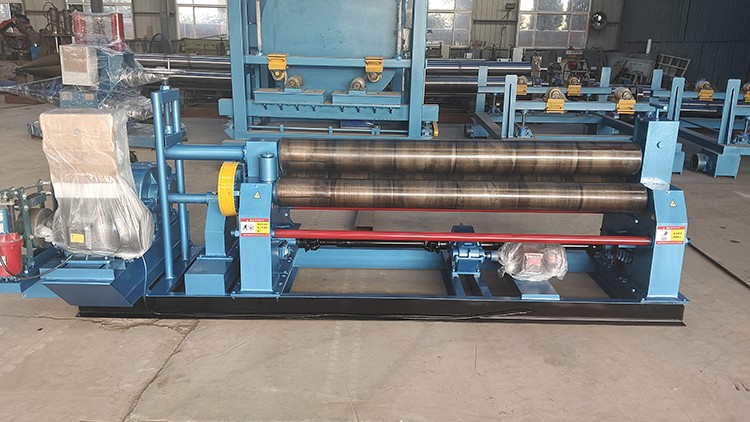

We are a professional plate rolling machine manufacturer with more than 10 years industry experience. Today, we would like to introduce to you the common methods for repairing the wear and tear of roll shafts of plate rolling machines:

Plate rolling machine is an important equipment in sheet metal processing, its roller shaft is subjected to high pressure and friction for a long time, and is prone to wear and tear. Roller wear will affect the processing accuracy, and even lead to the equipment can not operate normally. For the roller wear problem, the commonly used repair methods include cladding repair, laser cladding, brush plating and machining repair. Each of these methods has its own characteristics and should be selected according to the degree of wear, equipment requirements and economy.
1, Surfacing repair
Overlay repair is a method of restoring the size and performance of rollers by depositing weld metal on the worn parts. During operation, the wear parts are first cleaned to remove oil and oxidized layer, followed by layered overlay welding by arc welding or gas shielded welding. The overlay material is usually chosen as a wear-resistant alloy to improve the life of the repaired roll shaft.
The advantage of cladding repair is that the cost is low, applicable to a large area of wear repair. However, thermal deformation may occur during the welding process, requiring strict control of welding parameters and stress relief annealing after welding. In addition, the cladding layer may have porosity or cracks, which need to be detected to ensure the quality.
2, Laser cladding
Laser cladding utilizes a high-energy laser beam to fuse alloy powder onto the worn surface, forming a dense wear-resistant layer. This method has a small heat-affected zone and low deformation, which is suitable for the repair of high-precision rollers. The laser cladding layer is firmly bonded to the substrate, and different alloy powders can be selected according to the needs to improve the wear resistance or corrosion resistance of the rollers.
The repair quality of laser cladding is higher, but the equipment investment is larger, suitable for the occasions with strict requirements on precision. The laser power and scanning speed should be precisely controlled to avoid defects in the cladding layer.
3, Brush plating repair
Brush plating is used to restore roller dimensions by electrochemically depositing a metal coating on the worn surface. When repairing, the plating pen is dipped into the electrolyte and repeatedly brushed on the worn area until the desired thickness is achieved. Brush plating is easy to operate and does not require disassembly of the rollers, making it suitable for repairing minor localized wear.
The advantages of brush plating are fast repair, uniform plating and minimal thermal influence on the base material. However, the thickness of the plating layer is limited, generally not more than 0.5 mm, so it is not applicable to the case of severe wear. In addition, the wear resistance of the plating layer is usually lower than that of the cladding or laser cladding layer, and the plating material needs to be selected according to the actual working conditions.
4, Machining repair
Machining repair involves removing the wear layer by turning or grinding and reworking the rollers to standard dimensions. This method is suitable for small amounts of wear and allows for a reduction in the diameter of the rollers. After repair, the balance and concentricity of the rollers are better, but their overall strength and service life are reduced.
If repair by machining is used, it is necessary to ensure that the remaining wall thickness still meets the strength requirements. For important rollers, surface strengthening treatments, such as quenching or spraying with wear-resistant coatings, can be applied after machining to improve their durability.
5. Choice of restoration method
The following factors need to be considered when choosing a restoration method:
Degree of wear: Brush plating or machining can be used for minor wear, while cladding or laser cladding is required for severe wear.
Precision requirements: High-precision rollers are preferred to be laser fused or machined to minimize deformation.
Economy: Cladding is less expensive, laser cladding is better but more expensive.
Subsequent use of the environment: If the rollers need to withstand high loads or corrosive media, wear-resistant, corrosion-resistant repair process should be selected.
6. Post-restoration treatment
Regardless of which repair method is used, the necessary follow-up treatment is required after repair, such as finishing, dynamic balance correction and hardness testing. For rollers repaired by cladding or laser cladding, a flaw inspection is also required to ensure that there are no cracks or porosity. Finally, the service life of the rollers can be further extended by surface polishing or coating.
Repair of wear and tear of rollers of plate rolling machines requires the selection of appropriate methods according to the actual situation. Surfacing repair is economical and practical, laser cladding has high precision, brush plating is suitable for small-scale repair, and machining is suitable for situations that allow size adjustment. Reasonable repair process can not only restore the function of the roll shaft, but also improve its durability and reduce equipment maintenance costs.
If you are interested in plate rolling machine, please contact us.
 Address:Room 1202, Detaitang Building, No. 118 Huaguang Road, Zhangdian District, Zibo, Shandong
Address:Room 1202, Detaitang Building, No. 118 Huaguang Road, Zhangdian District, Zibo, Shandong WhatsApp:+8615653328535
WhatsApp:+8615653328535 Wechat: +8615965331535
Wechat: +8615965331535  E-mail:zs@sdsmachinery.com
E-mail:zs@sdsmachinery.com